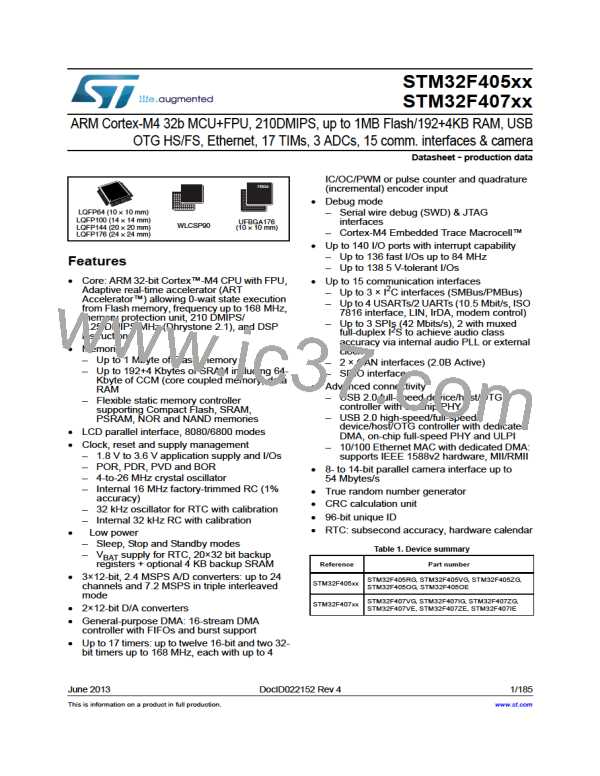Electrical characteristics
Symbol
STM32F405xx, STM32F407xx
(1) (2)
Table 31. HSE 4-26 MHz oscillator characteristics
Parameter
Conditions
Min
Typ
Max Unit
fOSC_IN Oscillator frequency
4
-
-
26
-
MHz
RF
Feedback resistor
200
kΩ
VDD=3.3 V,
ESR= 30 Ω,
CL=5 pF@25 MHz
-
-
449
532
-
-
IDD
HSE current consumption
µA
VDD=3.3 V,
ESR= 30 Ω,
CL=10 pF@25 MHz
gm
Oscillator transconductance
Startup time
Startup
5
-
-
-
-
mA/V
ms
(3)
tSU(HSE
VDD is stabilized
2
1. Resonator characteristics given by the crystal/ceramic resonator manufacturer.
2. Based on characterization, not tested in production.
3. tSU(HSE) is the startup time measured from the moment it is enabled (by software) to a stabilized 8 MHz
oscillation is reached. This value is measured for a standard crystal resonator and it can vary significantly
with the crystal manufacturer
For C and C , it is recommended to use high-quality external ceramic capacitors in the
L1
L2
5 pF to 25 pF range (typ.), designed for high-frequency applications, and selected to match
the requirements of the crystal or resonator (see Figure 32). C and C are usually the
L1
L2
same size. The crystal manufacturer typically specifies a load capacitance which is the
series combination of C and C . PCB and MCU pin capacitance must be included (10 pF
L1
L2
can be used as a rough estimate of the combined pin and board capacitance) when sizing
and C .
C
L1
L2
Note:
For information on electing the crystal, refer to the application note AN2867 “Oscillator
design guide for ST microcontrollers” available from the ST website www.st.com.
Figure 32. Typical application with an 8 MHz crystal
Resonator with
integrated capacitors
C
L1
f
OSC_IN
HSE
Bias
controlled
gain
8 MHz
resonator
R
F
STM32F
OSC_OUT
(1)
R
EXT
C
L2
ai17530
1. REXT value depends on the crystal characteristics.
Low-speed external clock generated from a crystal/ceramic resonator
The low-speed external (LSE) clock can be supplied with a 32.768 kHz crystal/ceramic
resonator oscillator. All the information given in this paragraph are based on
characterization results obtained with typical external components specified in Table 32. In
the application, the resonator and the load capacitors have to be placed as close as
possible to the oscillator pins in order to minimize output distortion and startup stabilization
time. Refer to the crystal resonator manufacturer for more details on the resonator
characteristics (frequency, package, accuracy).
98/185
DocID022152 Rev 4

 STMICROELECTRONICS [ ST ]
STMICROELECTRONICS [ ST ]